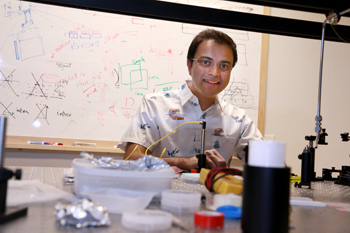The White House BRAIN initiative promises to revolutionize our understanding of the human brain by supporting development of dynamic approaches for investigating brain function. Forging a synergistic partnership with the University of Utah, the National Science Foundation awarded $2.77 million in BRAIN Initiative grants to neuroscience faculty in 2015.
Founded in 2014, the U of U’s Neuroscience Initiative is reinforcing this partnership by continuing to build an infrastructure to spark and support innovative, interdisciplinary research that meet BRAIN Initiative.
The BRAIN Initiative projects are:
 Cracking the Olfactory Code
Cracking the Olfactory Code
The mammalian sense of smell is one of the most complex sensory systems. This interdisciplinary collaboration between six institutions aims to understand how the brain detects, encodes, and extracts meaning from odors.
Analysis of the Mammalian Olfactory Code – $766,000
Matt Wachowiak, Ph.D., Neurobiology and Anatomy
 Deep Brain Imaging to Better Understand Learning and Memory
Deep Brain Imaging to Better Understand Learning and Memory
Interrogating the fundamental basis of information processing and memory has remained largely inaccessible due to a lack of non-invasive tools. This project aims to develop innovative, inexpensive technologies to visualize the inner workings of deep neural networks and their connections at high resolution in behaving animals. Imaging synaptic activity deep in the brain using super-resolution cannula microscopy
Imaging synaptic activity deep in the brain using super-resolution cannula microscopy – $920,000
Rajesh Menon, Ph.D., Electrical and Computer Engineering
Erik Jorgensen, Ph.D., Biology
Jason Shepherd, Ph.D., Neurobiology and Anatomy
 New Model for Investigating Mechanisms of Behavior
New Model for Investigating Mechanisms of Behavior
No bigger than the tip of your finger, the tropical fish Danionella translucida is optically transparent throughout life, offering scientists a window into the brain. This project will adapt sophisticated genetic, optical, and molecular techniques for use in this new model species to explore how brain activity creates complex behaviors.
Danionella translucida: A New Fish Model for Systems Neuroscience – $300,000
Adam Douglass, Ph.D., Neurobiology and Anatomy
 A Prosthetic Arm that Moves and Feels
A Prosthetic Arm that Moves and Feels
The team aims to create and test hand and arm prostheses that can move and feel sensation nearly as well as their biological counterparts. The work is made possible by the Utah array, a neural interface developed at the University of Utah.
Sensory-Motor Integration via Recording and Stimulating Arm Nerves – $785,615
David Warren, Ph.D., Bioengineering
Douglas Hutchinson, M.D., Orthopaedics
Greg Clark, Ph.D., Bioengineering